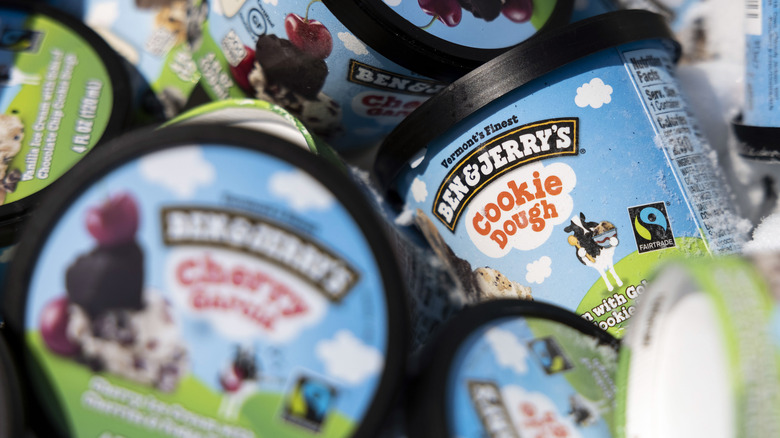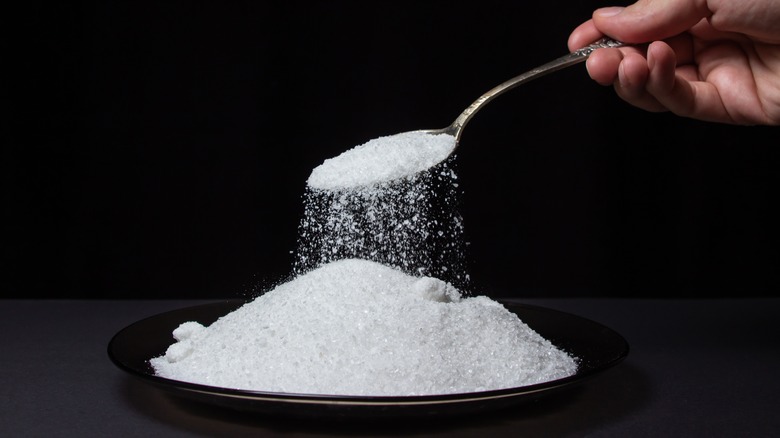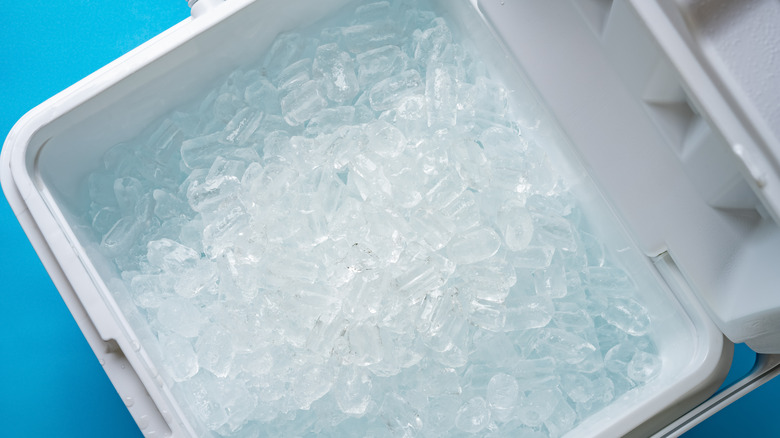Salt Is The Secret Ingredient That Keeps Ice Cream Frozen In A Cooler
After a long day in the sun at a cookout, a sweet frozen treat is a uniquely satisfying refreshment. However, keeping ice cream perfectly frozen even after you've set the table, polished off the burgers, and the emptied the drinks can be a challenge. Insulated coolers, are helpful as they are, aren't always a foolproof solution, and you need to pack them wisely to keep ice cream from going soft. To stave off dessert disappointment, use salt to maintain an extra-chilly temperature.
To try this hack, line the bottom of your insulated plastic cooker with ice and pour some very generous shakes of salt across the entire thing. Then, rest your cartons of ice cream on top. You can add extra insulation by adding sheets of foam or bubble wrap, which helps your cooler function like an ice-cold freezer. Bury the ice cream under enough ice to fill the whole cooler and finish with more salt. Kosher salt, iodized salt, or even rock salt can all get the job done.
It's important to note that the ice cubes might melt faster, thanks to the added salt, but this doesn't mean the cooler is too warm. The chemical properties of the salt actually make the melted ice colder than solid ice, keeping everything from sorbet to nondairy ice cream frozen solid. And if you want to take along ice pops, burying Popsicles at the very bottom of the cooler with salt and ice will also keep them in peak condition.
Why does salt keep your ice cream frozen?
Now, you may be wondering: Since we pour salt on roads in the winter to make the ice melt, how can the same mineral keep your ice cream from turning soft? The answer comes down to basic chemistry. Water typically solidifies into ice at a freezing point of 32 degrees Fahrenheit; below this temperature, ice starts to melt. Sodium chloride, or table salt, lowers the freezing temperature of solid ice, so that it melts more readily. The more salt you add, the lower the freezing point becomes.
This means that even in a chilly freezer, salted water will remain liquid, even if it gets colder than 32 degrees F — so just because the ice has melted doesn't mean it has become warmer. When you combine ice and salt in your cooler, the salted cubes turn watery, but hold onto their frosty temperatures; in fact, they can get colder than plain ice. So even though the ice around your ice cream will turn slushy, rest assured that the salted water is actually super cold, and will protect all your dairy-based treats.
Although the salt in your cooler shouldn't impact the taste of your ice cream, you can place your pints and boxes in resealable bags first, just for assurance. Another fun fact: Sugar lowers ice's freezing point, too, so you can maximize this tailgate science experiment by choosing sweeter ice cream flavors, resulting in the coldest scoops.
Other tactics to keep your cooler ice cold
Although the summer sun is the main draw for outdoor gatherings, it's also the enemy of your cooler. Even with insulation, sunlight will counteract the power of the cool outer shell. That's why it helps to take a strategic approach when preparing and loading perishable items inside.
First, try to pre-chill the vessel by filling it with ice the day before use. This is also a good time to turn your freezer to its coldest settings, ensuring that your ice cream and other frozen goods are as solid as possible when it's time to transport them. When adding ice cubes and/or packs to the cooler, try to use a variety of sizes, like big blocks and smaller cubes. Large chunks take longer to melt, while petite pieces can surround your individual ice cream cartons more effectively.
When it comes time to pack for the day, make sure to load items to maximize your cooler space, and consider placing high-traffic items, like drinks, in their own cooler. Overloading a single cooler equals much less efficient freezing, especially for delicate ice cream. Most importantly, use lots of ice — for every ice cream pint, add double the volume of ice cubes. Plug up any remaining space in the cooler with clean towels to keep air out. Many tailgaters drain their coolers throughout the day, but you should resist the urge — like we said, the melted salty water is key for chilling.



